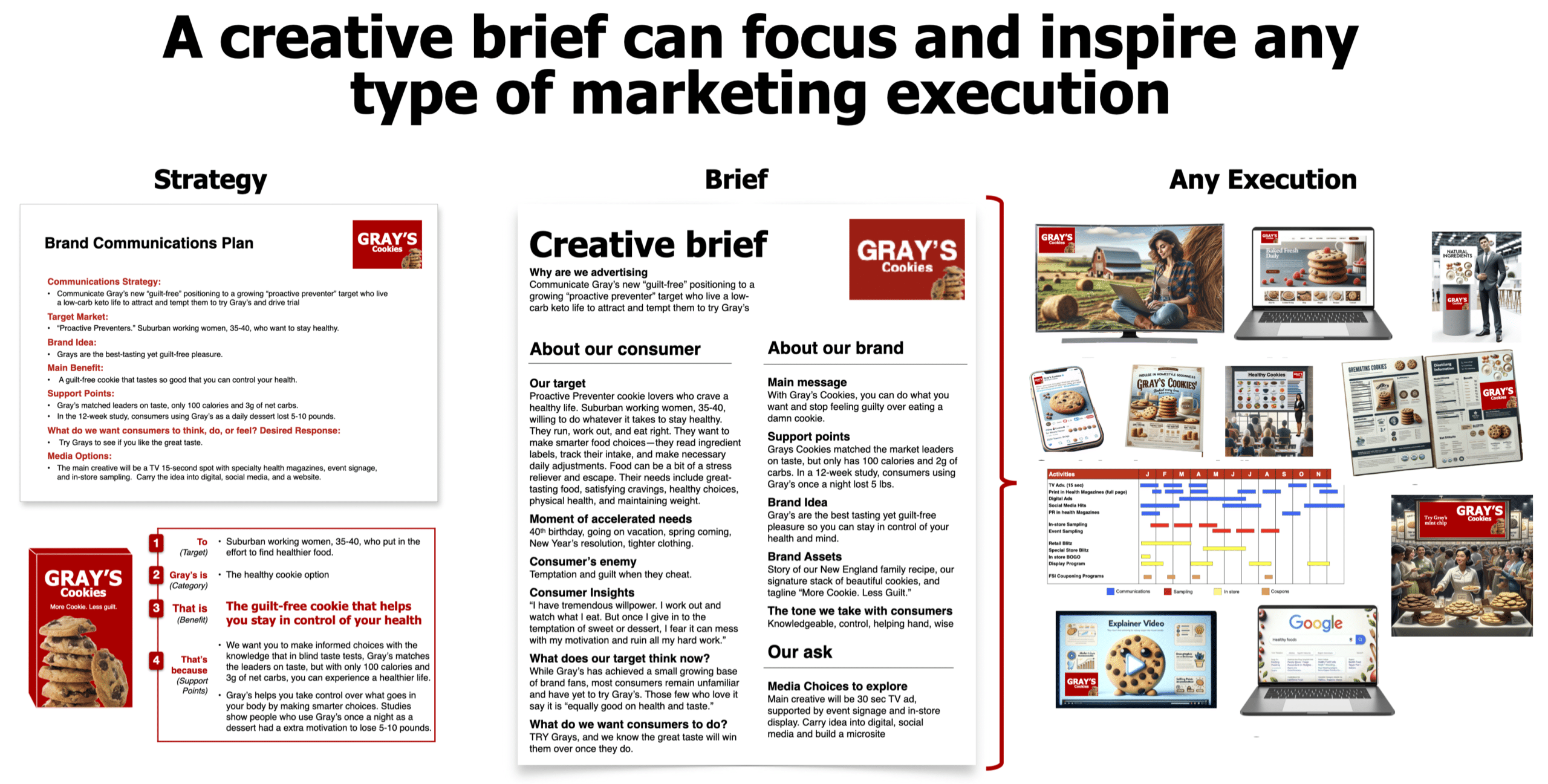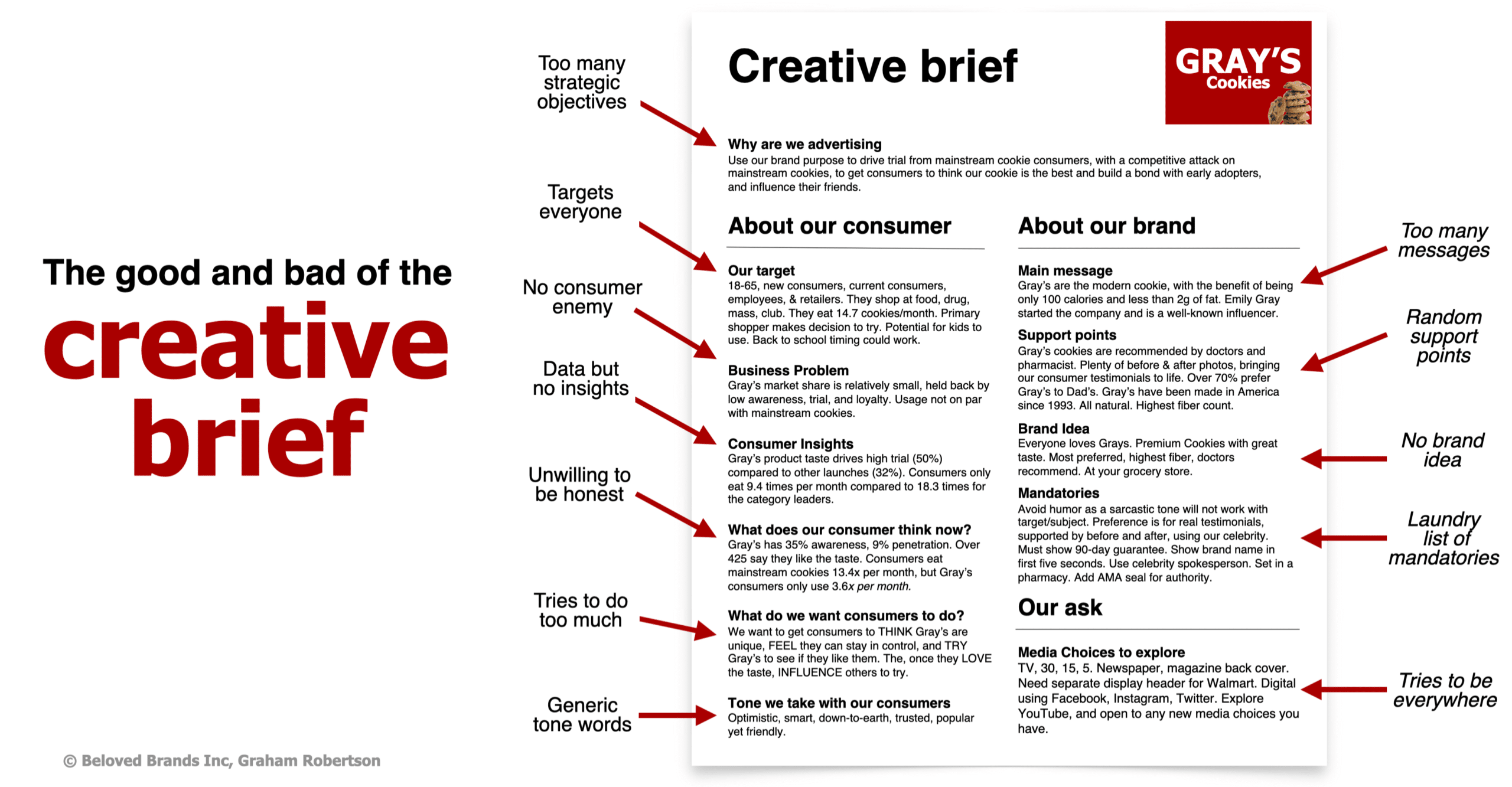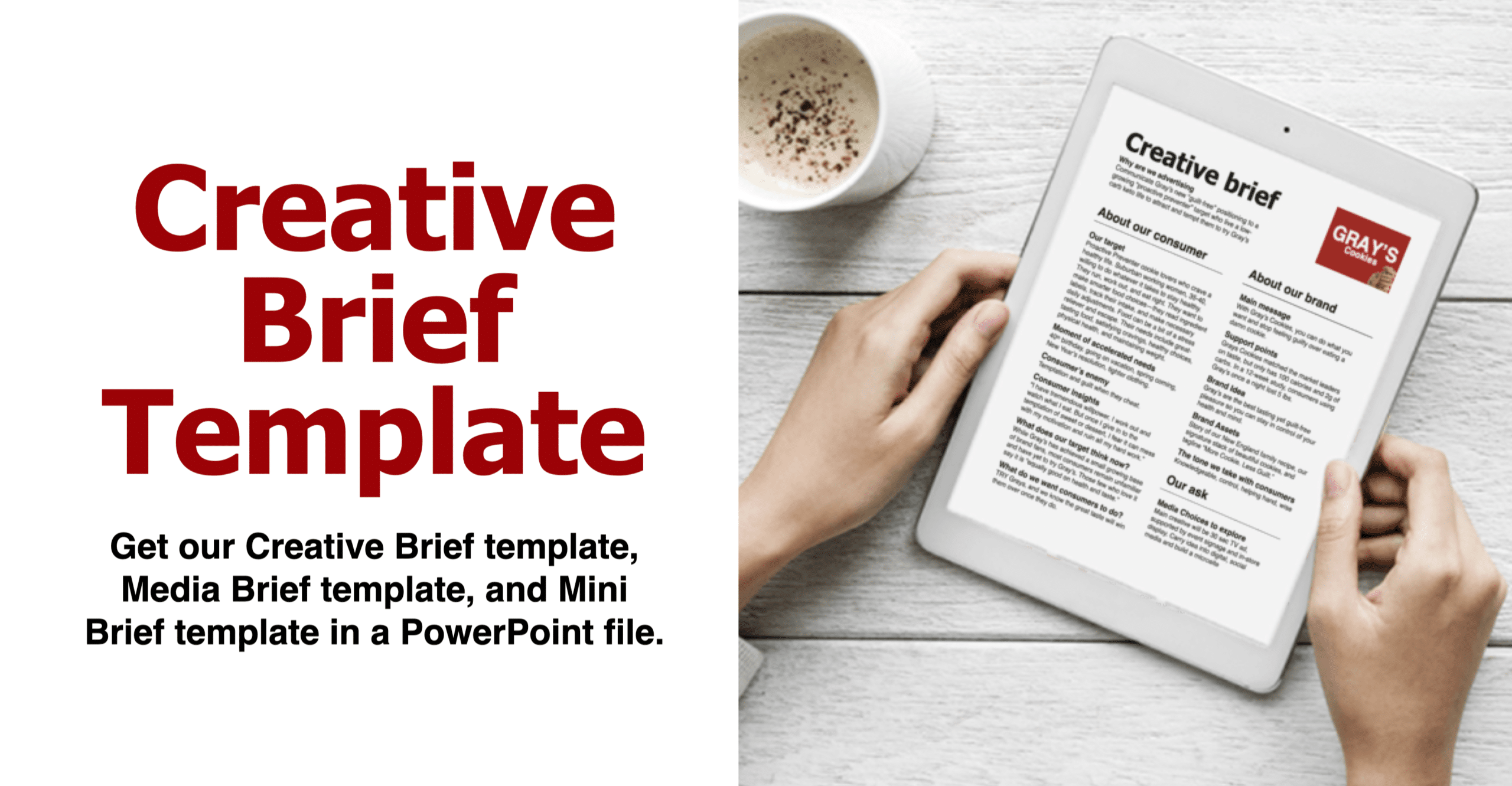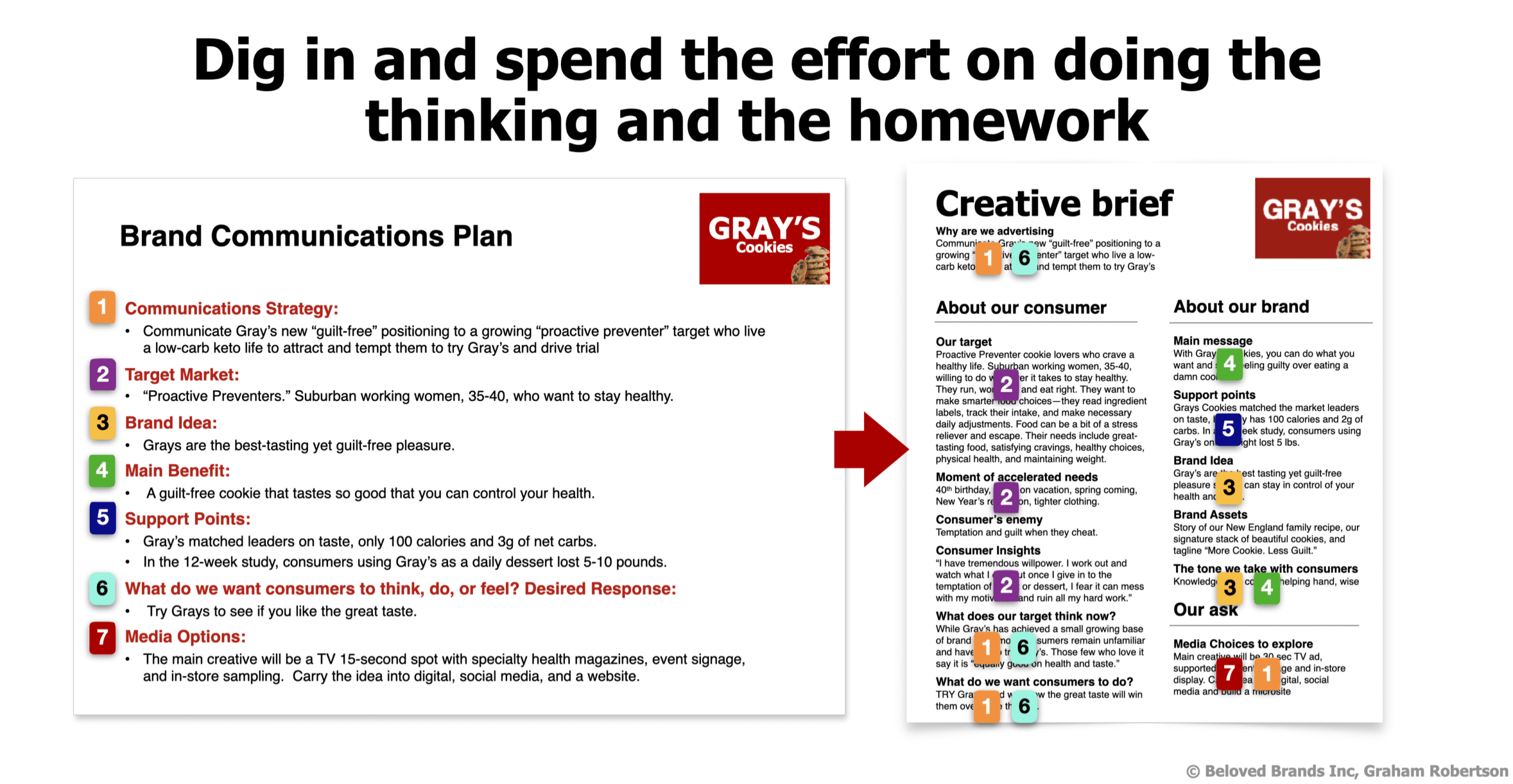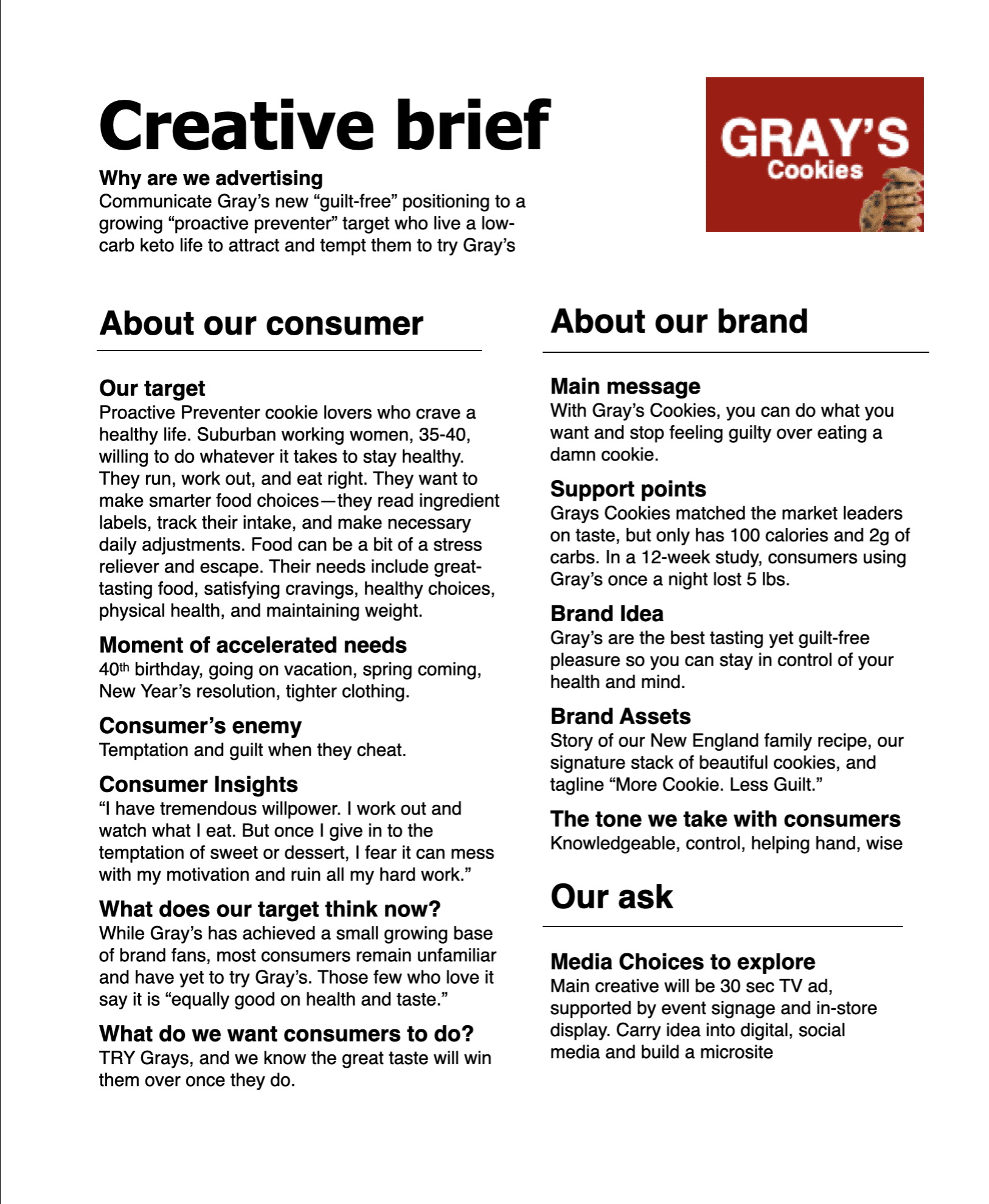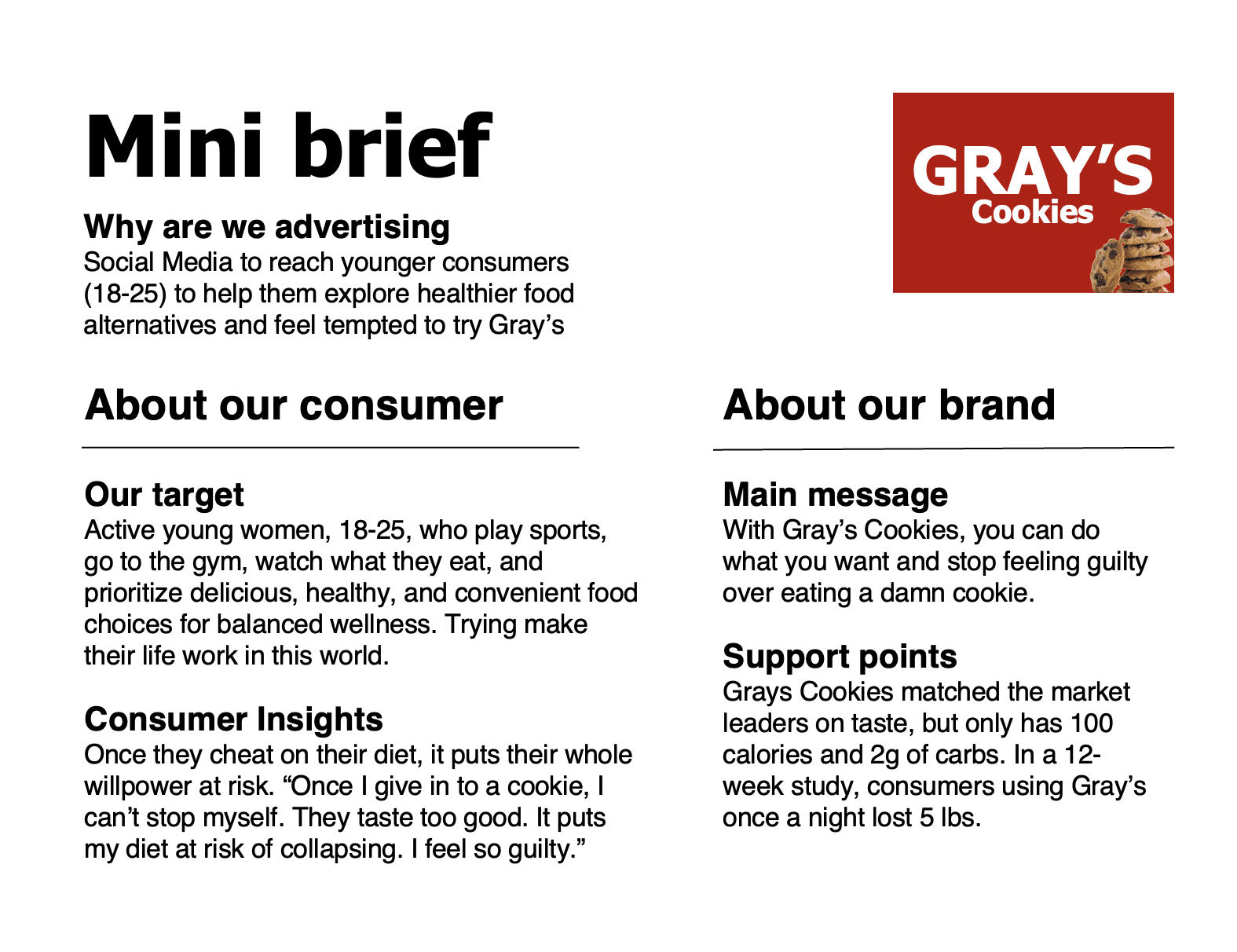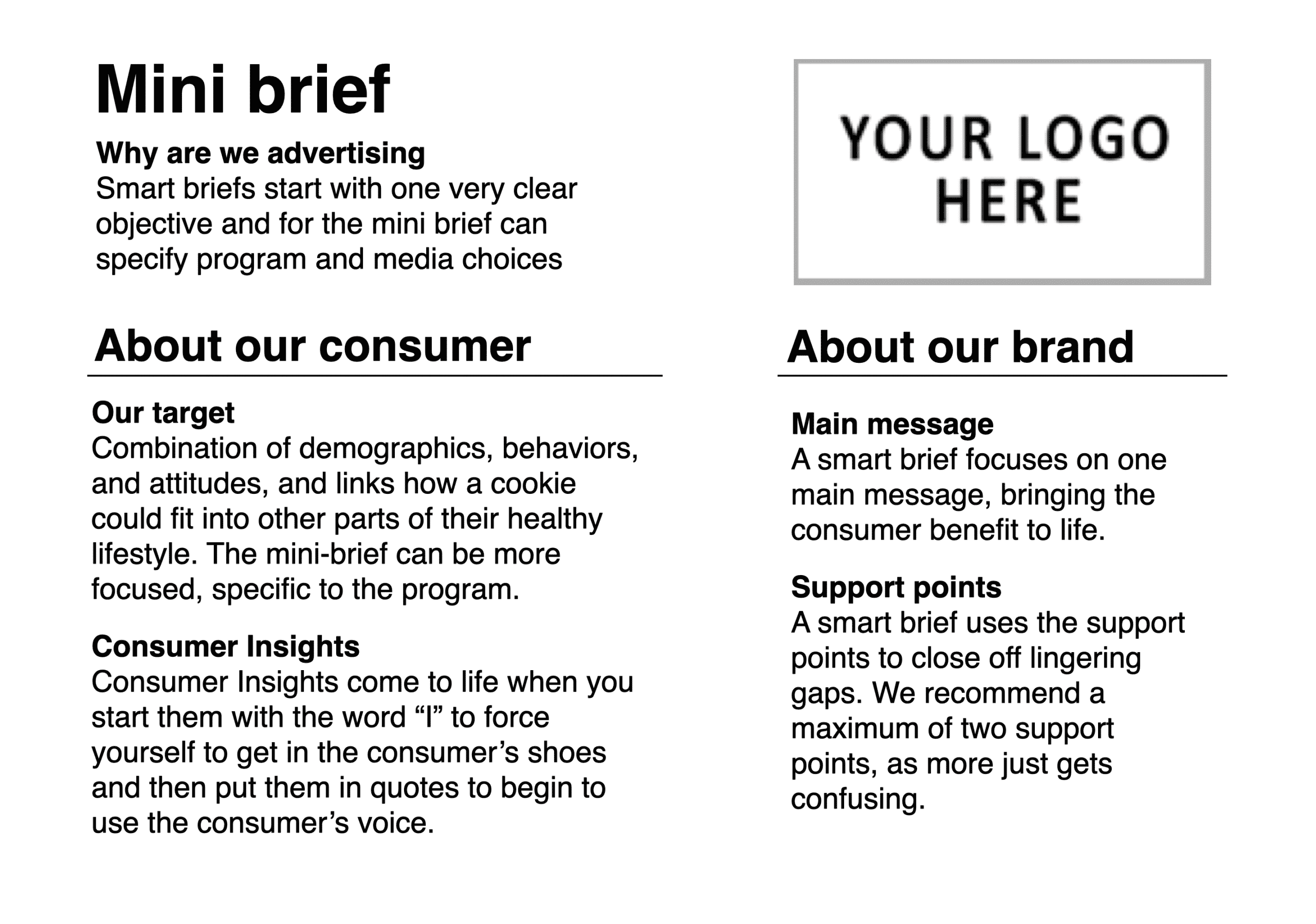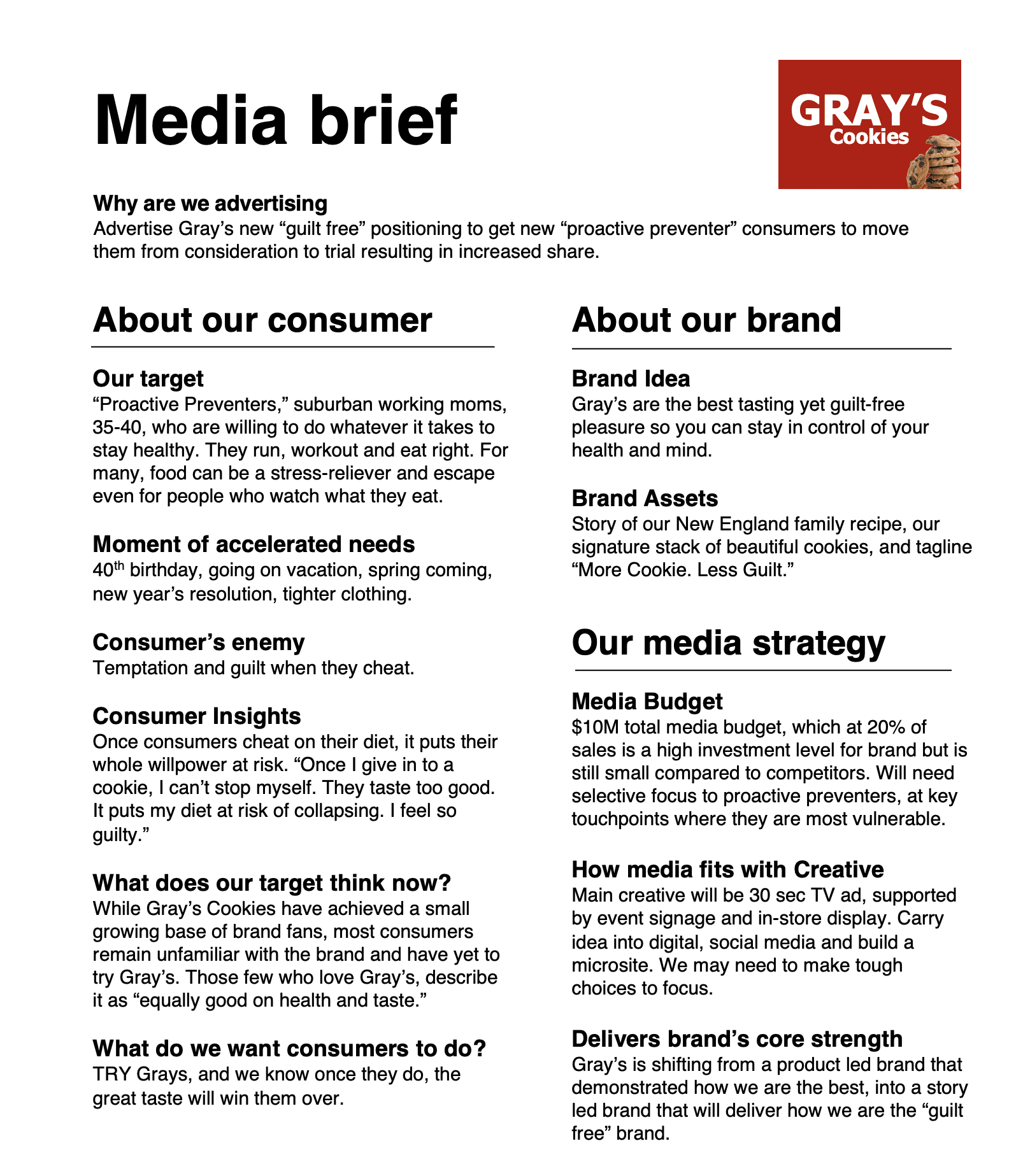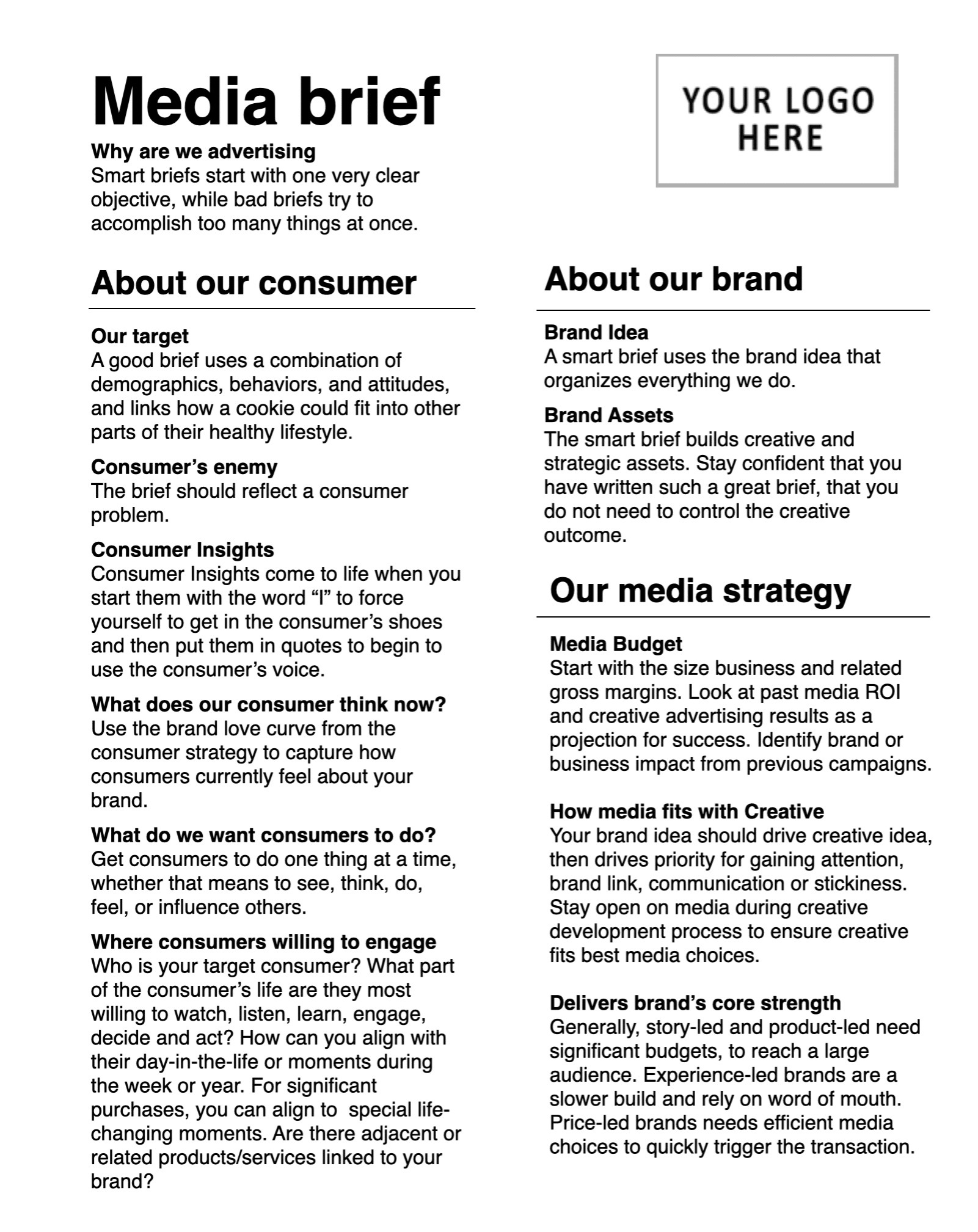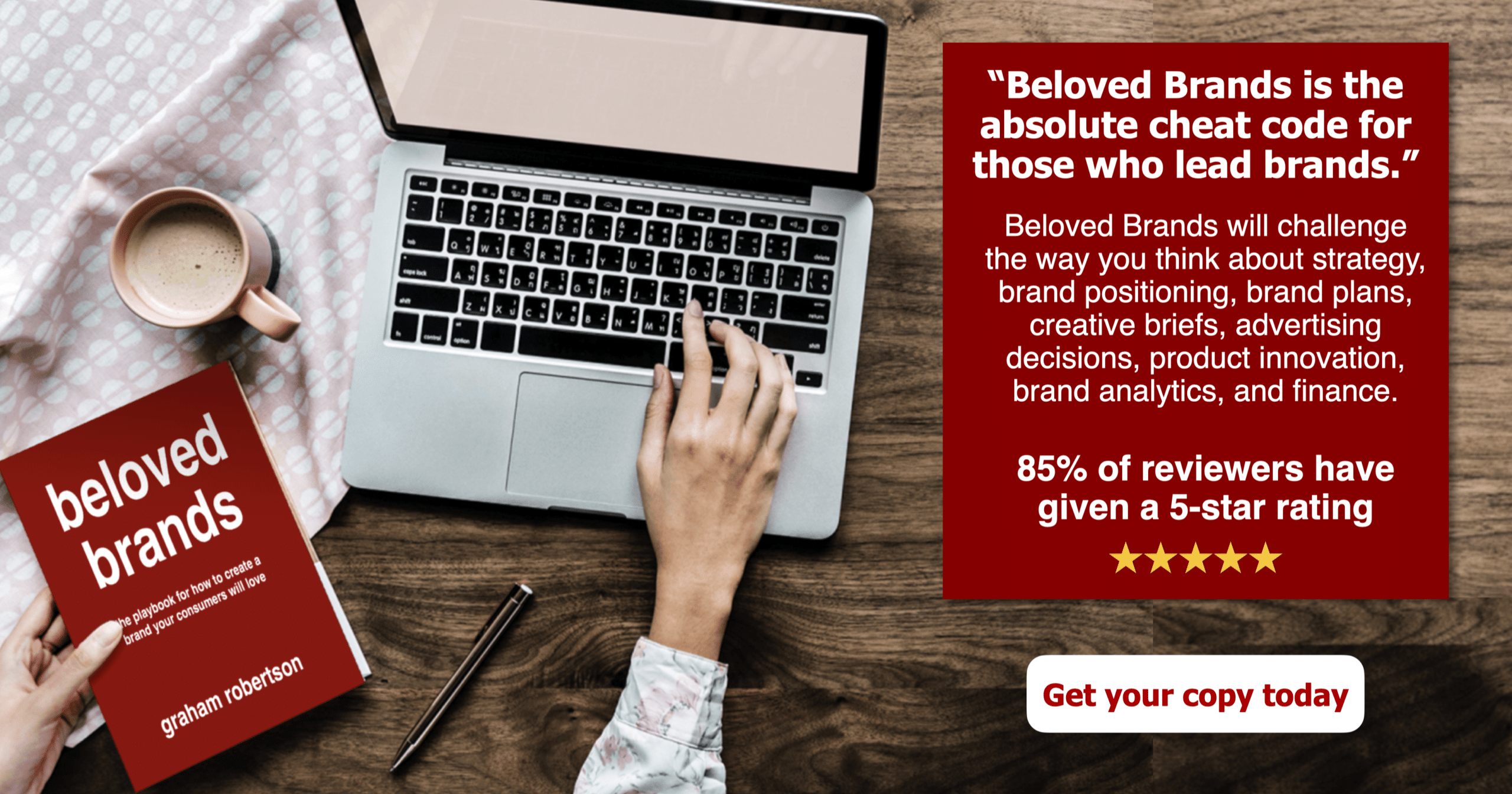I wish everyone would stop writing ugly creative briefs. Most importantly, the creative brief is a crucial way for brand leaders to control the strategy. On the other hand, make sure you give freedom on execution to the experts who execute. Too many marketers have this backward, preferring to give freedom on strategy with various possible strategic options layered within the creative brief. Then, they attempt to try to control the creative outcome by writing a long list of tangled mandatories. We will use our creative brief template and a creative brief example to show you how to write every line of the brief.
To illustrate, click on the Creative Brief example above.
The role of the creative brief is the bridge between your strategic plan and any marketing execution. You should have one for any advertising, content marketing, logos, packaging design, websites, videos, or conferences. The creative brief distills everything you could say into only those elements that matter.
Your creative brief should have a clear, single-minded objective of what you are looking to do, a tightly defined target, consumer insights that explain your consumer, the overarching brand idea the work needs to fit, the main message you want to communicate, and any support points that will help reinforce your message.
Creative Briefs - Table of Contents
The role of the Creative Brief
Managing the creative brief process
Before writing your Creative Brief, dig in on the brand positioning work and the marketing plan. The role is to summarize what matters in delivering creative work that matches up to the brand strategy. It can be used for any type of execution. Advertising. Social Media. Packaging. In-store signs or displays.
The flaw you create with a big wide brief
When you write a big-wide creative brief with layers of options within the brief, the agency just peels the brief apart and gives you strategic options. For instance, if you put a big wide target market of 18-55 years-old, your agency will present one ad for 18-25 years-old, another one for 25-40 years-old and the third ad for 40-55 years-old. In conclusion, if you put two objectives into the brief, asking to drive trial and drive usage, you will get one ad idea for driving trial and one ad idea for usage.
This means you are picking your brand strategy based on which ad idea you like best. That is wrong. Pick your strategy first and use the creativity of execution to express that strategy.
The good and bad of the creative brief.
Our post will go through line-by-line and show examples of the good and bad of each line. The biggest flaw I see is the lack of focus on the target, main message, and strategic objective. To illustrate, click Good and Bad.
The brief should define “the strategic box” for the creative to play within.
Most great advertising people I have met are problem solvers, not inventors. I would describe them as ‘in-the-box’ creative thinkers, not blue-sky’ out-of-the-box’ dreamers. If they need a good problem to solve, then give them your problems, but never your solutions. Never give your creative team a blank slate or blank canvas and ask them to come up with an ad. Use the creative brief to create the right box for them to play in and solve your problem.
When I see marketers writing a big, wide brief with too many objectives, a vague target, and cluttered messaging, I wonder if they have unknowingly created too much strategic freedom. While you might think writing a big, wide creative brief provides room for creativity, it does not. Your agency will see you as confused and will likely peel the brief apart, rewrite the brief how they want, and then provide you with strategic options instead of creative options. The problem is that you will choose your strategy based on which ad you like.
When I see marketers write a big, long laundry list of mandatories, everyone knows they are just trying to control the creative output. Do not create a tangled web of mandatories that almost write the ad itself, or you will trap the creative team into taking various elements from the mandatory list and building a Frankenstein-type ad. Above all, if you want great work—and I know you do—give your agency the creative freedom they need.
Here is what creative people do not want from you:
- A blank canvas: Creative people would prefer a business problem to solve, not a wide-open request for advertising options.
- An unclear problem: Creative people need a tightly defined and focused problem to generate great work that meets your needs.
- A long list of mandatories: Do not create a tangled web of mandatories that almost write the ad itself. These lists only trap the creative team, holding them back from doing anything breakthrough, surprising or spectacular.
- Your Solutions: Creative people find it demotivating to be asked for their expertise (solving problems) and then not be fully utilized (given your answer).
Keep the brief small
A smart creative brief should be brief and not long. Avoid the “Just in Case” list by taking your pen and stroking a few things off! It is always enlightening when you tighten it by making tough decisions about what goes into the brief, so you narrow it down to:
- One objective
- One desired consumer response
- A target tightly defined
- One main benefit
- Finally, use up to two main reasons to believe
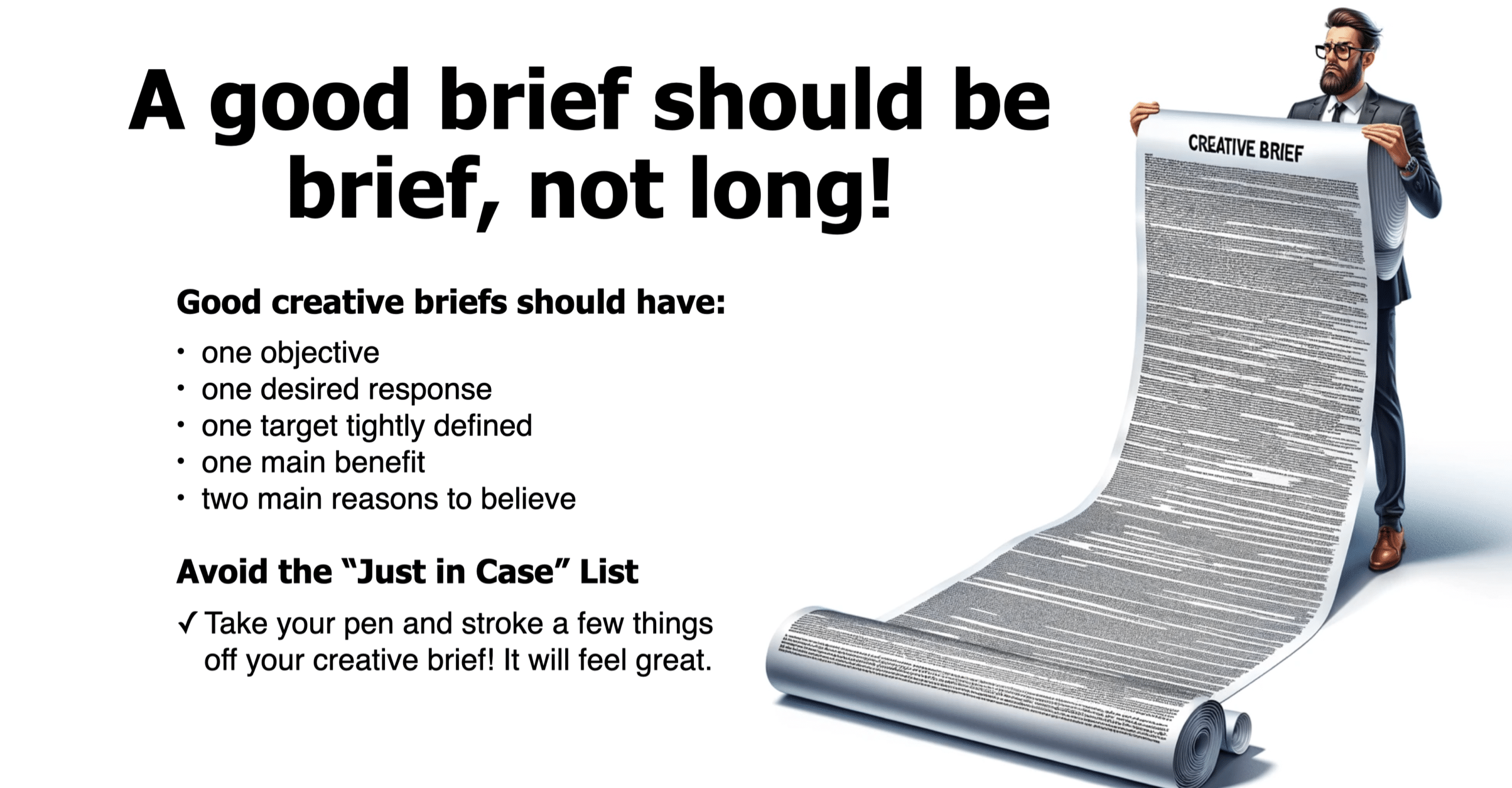
How to write a creative brief
1. Define a tight target:
- First, do not spread your limited resources against a target so broad that it leaves everyone thinking your message is for someone else. Target the people who are the most motivated by what your brand does best, and make your brand feel personal so your target consumer feels special. A brand must make consumers think, “This brand is for me.”
2. Drive one objective at a time:
- Next, build advertising that gets consumers to do only one thing at a time, whether it’s something you want them to see, think, do, or feel, or influence their friends. Most importantly, force yourself to make a decision that links the advertising objective with your brand strategy.
3. Drive one main message at a time:
- Then, do not put so many messages into your ad; consumers will see and hear a cluttered mess. They will shut down their minds and reject your ad. They will not know what your brand stands for. In other words, you will never build a reputation for anything.
4. Talk about consumer benefits, not about your product features:
- Finally, start a conversation that shows what the consumers get or how they will feel. Do not just yell features at the consumer. Moreover, use your brand idea to simplify and organize your brand messaging.
How to transform your strategy into a creative brief
Let’s look at the seven questions of the brand communications plan
- First, who is in our consumer target?
- Second, what is the main benefit we are selling?
- Third, why should they believe us?
- Then, what is our organizing brand idea?
- Next, what do we need our advertising to do?
- For the objective, what do we want people to think, feel or do?
- Finally, where will our consumer be most receptive to see and act upon our brand message?
Do the strategic homework you developed through the brand communications plan, and begin to populate the 12 questions of your creative brief. Below, we can see how to use our creative brief example to build on the brand communications strategy, which should be part of your marketing plan.
The work that you do to create a Brand Communications Plan within your Marketing Plan helps steer the writing of your Creative Brief. It combines the brand positioning and brand strategy. To illustrate, click on the creative brief example above.
Creative brief template
Take everything you know about the brand and strategically desire, and distills it down to one page. Below you can see our Creative Brief example as well as the blank slide from our Creative Brief template.
To illustrate, click on the Creative Brief example and our Creative Brief template.
Mini brief template
Going too fast sometimes takes too long. With the explosion of media options, timing is everything. Unfortunately, there are too many “phone call briefs” happening. Even worse, no brief at all. Accordingly, when in a rush, use our mini creative brief.
To illustrate, click on the Creative Brief example or our Creative Brief template.
Media brief template
Our media brief template allows you to brief your media team. It follows the same pattern as our creative brief. Read about how to build a media strategy.
To illustrate, click on the Media Brief example or our Media Brief template.
Creative Brief frequently asked questions
What is a creative brief?
The creative brief bridges the strategy in a marketing plan and the marketing execution. You can use it for any type of marketing communications: advertising, packaging, websites, Digital Media, retail merchandising, Social Media, events, and Sales Material. The role is to set the parameters for the creative people. It guides them on the strategy, main messages, and media choices.
What should a creative brief include?
It should include a strategic objective statement at the top. Match up the desired consumer response to the objective. Then, define the target market. Add flavor with consumer insights. In terms of the message, include the main benefit and up to two main reasons for believing.
What is the most important part of a creative brief?
The most important part is the objective and main message. What are you trying to do? And what are you trying to say?
Who writes the it?
When I was in marketing, the strategic planner at the creative agency wrote the brief. That worked when a brand had one main agency. Now, a brand might work with multiple agencies. First, a brand might have an agency for traditional advertising. Second, a brand would have an agency-specific to digital or social media. Third, there are agencies for retail merchandising, PR, or professional markets. Finally, the brand might have a design agency that looks at logos and the look and feel of the brand. With the proliferation of agencies, the brand manager often writes the creative brief. Some might refer to this as a marketing brief. The agency would then write its own version. They will put more inspirational thinking into the creative brief when this happens. It’s ok to have two briefs as long as the brand manager knows which one they will use to make their advertising decisions.




